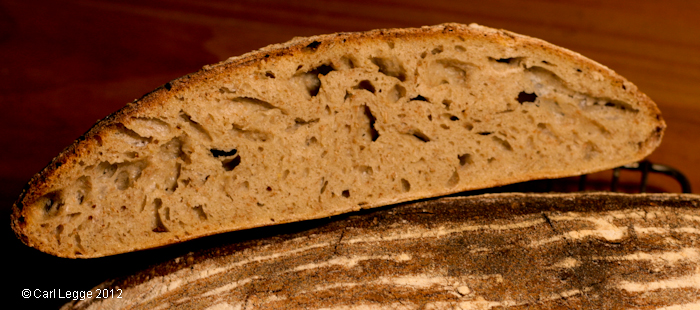Romeo, the hate I bear thee can afford
No better term than this,—thou art a villain
Now why would you name a wheat after someone who would say that?
I think this Particular Tybalt, unlike Romeo’s assailant, is more fiery in name than in nature.
This is another test bake of one of the flours I received the the Felin Ganol Mill. This particular flour is a fine grained white flour. I decided to use is as part of my normal bake of 2.7kgs of sourdough along with some Felin Ganol wholemeal spelt. Anne & Andrew say on the packet that they recommend it is mixed with 30% strong white flour. What I did was replace some of my usual strong white bread flour with the Tybalt.
Here’s the formula I used…
Tybalt & Spelt Sourdough Bread Recipe
Ingredients
750g Felin Ganol white Tybalt flour
450g Shipton’s No 4 strong white flour
300g Felin Ganol wholemal spelt flour
300g 100% hydration starter (refreshed with the FG Tybalt & FG Spelt)
920g warm water
27g fine sea salt
Method
I used the same method as my last test bake with the Amaretto flour.
You’ll see that the hydration of the dough at about 65% is my ‘normal’ hydration. I kept to this despite some information from Azelia on her blog to the effect that it doesn’t need as much water. This wasn’t just me being peverse. I wanted to see how it handled in direct comparison to my normal dough. The only difference between this and my normal formula is the replacement of some of the No 4 with the Tybalt. So I knew whatever changes I observed were down to the flour characteristics in the starter and in the main mix.
The first mix of the dough before adding the salt felt as normal.
After adding the salt and remaining 50g water, the handling characteristics of the dough were noticeably different. The dough felt ‘softer’ and didn’t achieve the same resilience through the folding process.
After the overnight retard in the fridge, the dough had puffed up very well and was still very very ‘soft’. By this time, I knew I was going to have some ‘spreading loaves’ due to the hydration of the dough. The dough felt like my normal dough with perhaps 5-10% more water.
My observation was confirmed by the shaping of the dough for the bannetons. The dough shaped well, but was not as ‘pert’ as usual. I proved the loaves for about 2.5 hours and then baked them as normal.
The loaves went out of the bannetons onto the the peel like pancakes. I had visions of taking pictures of discus stand ins. After about ten minutes in the oven it was clear that the loaves would spring and not be completely flat.
I was expecting the loaves to colour quickly like the Amaretto did and as Azelia reported in her posting. They did not and this may be because there was only 50% Tybalt in the dough.
I baked the loaves for about 50 minutes in total. They baked out very nicely in the end, if somewhat flatter than normal.
The Result

The crust smells malty, caramelly and tastes gorgeous. The crumb is very soft and the spelt provides a good colour and slightly nutty flavour. As you can see, the crumb is light and open – a function of the higher hydration for the flour type.
I think the taste of the bread is lightly better than my normal loaf but I didn’t feel that the taste of the Tybalt came through strongly in anything but the crust.
The first loaf was gone within six hours, which is a testament to how good it was.
I’d think that next I’d like to bake a loaf with 100% Tybalt to see how it feels and tastes by itself. I’d also cut the water down by 50g or so to see what happens to the dough handling.
In conclusion, this is a flour I want to get to know better. I think it has good possibilities for me.
Other posts you may like:

Comments
One response to “Felin Ganol – Tybalt Flour: Sourdough Bread”
The Tybalt flour sounds interesting-I will have to look out for it as I would like to give it a go too…